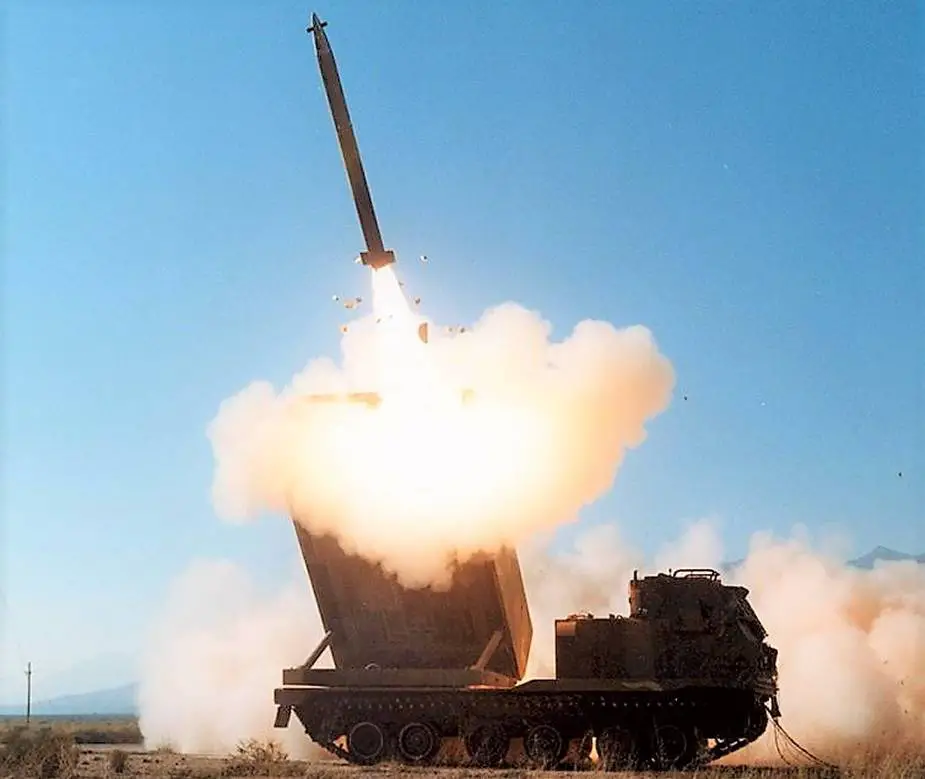The U.S. State Department has made a determination approving a possible Foreign Military Sale to the Government of Jordan of Guided Multiple Launch Rocket Systems (GMLRS) Alternate Warhead (AW) Unitary Rocket Pods and related equipment for an estimated cost of $70 million. The Defense Security Cooperation Agency delivered the required certification notifying Congress of this possible sale today.
Follow Army Recognition on Google News at this link

GMLRS launch from HIMARS at Chocolate Mountains Aerial Gunnery Range, California, 9 December 2020 (Picture source: USMC/Sgt Miguel A Rosales)
The Government of Jordan has requested to buy 114 Guided Multiple Launch Rocket System (GMLRS) Unitary High Explosive (HE) Tri-Mode Fuze (GMLRS-U) (M31) Rockets; and 114 Reduced Range Practice Rockets (RRPR). Also included is support equipment; publications and technical data; personnel training and equipment; systems integration support; U.S. Government and contractor engineering technical and logistics support services; and other related elements of logistics and program support. The estimated total cost is $70 million.
The principal contractor will be Lockheed Martin Missile and Fire Control, Dallas, TX. Implementation of this sale will not require the assignment of any additional U.S. Government or contractor representatives to Jordan.
The MLRS Family of Munitions (MFOM) includes a variety of precision-strike rockets and missiles, with on-going evolutionary development to meet the needs of the warfighter. These combat-proven low-cost, low-risk rounds greatly reduce collateral damage and provide tremendous capability and flexibility in addressing today’s threats.
Guided MLRS Specifics:
• Persistent, responsive, all-weather, rapidly-deployable, long-range, surface-to-surface, precision-strike capability
• Fired from both the MLRS M270 family of launchers and the High Mobility Artillery Rocket System (HIMARS) launchers
• 6 Guided MLRS rockets per launch pod, with 2 pods carried by the M270 launchers and 1 pod carried by the HIMARS launchers
• More than 40,000 Guided MLRS rockets produced to date and climbing
• Guided MLRS rockets have a reliability rating exceeding 98 percent
Current Guided MLRS variants include:
• Guided MLRS Unitary: The combat-proven Guided MLRS Unitary round integrates a 200-pound unitary warhead, providing a precision strike for point targets. The Unitary variant has a range exceeding 70 kilometers.
• Guided MLRS Alternative Warhead (AW): The Guided MLRS AW round was the first munition developed to service area targets without the effects of unexploded ordnance, complying with the U.S. Department of Defense cluster munitions policy and international policies. The AW variant has a range exceeding 70 kilometers and delivers a 200-pound class fragmenting warhead.
• Extended-Range (ER) Guided MLRS: A new developmental variation of the Guided MLRS family, ER GMLRS offers an extended range out to 150 kilometers in all weather conditions. ER GMLRS shares significant commonality with legacy Guided MLRS, and is deployable by M142 HIMARS and the MLRS M270 family of launchers. The rounds incorporate a larger motor and have enhanced maneuverability due to tail-driven control.

GMLRS rocket fired from M270 (Picture source: Lockheed Martin)
Alternative Warhead Program
In April 2012, Lockheed Martin received a $79.4 million contract to develop a GMLRS incorporating an Alliant Techsystems-designed alternative warhead to replace DPICM cluster warheads. The AW version is designed as a drop-in replacement with little modification needed to existing rockets. An Engineering and Manufacturing Development (EMD) program was to last 36 months, with the alternative warhead GMLRS expected to enter service in late 2016. The AW warhead is a large airburst fragmentation warhead that explodes 30 ft (9.1 m) over a target area to disperse penetrating projectiles. Considerable damage is caused to a large area while leaving behind only solid metal penetrators and inert rocket fragments from a 90 kg (200 lb) warhead containing approximately 182,000 preformed tungsten fragments. The unitary GMLRS also has an airburst option, but while it produces a large blast and pieces of shrapnel, the AW round's small pellets cover a larger area.
On 22 May 2013, Lockheed and ATK test-fired a GMLRS rocket with a new cluster munition warhead developed under the Alternative Warhead Program (AWP), aimed at producing a drop-in replacement for DPICM bomblets in M30 guided rockets. It was fired by an M142 HIMARS and traveled 35 km (22 mi) before detonating. The AWP warhead will have an equal or greater effect against materiel and personnel targets while leaving no unexploded ordnance behind.
On 23 October 2013, Lockheed conducted the third and final engineering development test flight of the GMLRS alternative warhead. Three rockets were fired from 17 kilometers (11 mi) away and destroyed their ground targets. The Alternative Warhead Program then moved to production qualification testing. The fifth and final Production Qualification Test (PQT) for the AW GMLRS was conducted in April 2014, firing four rockets from a HIMARS at targets 65 kilometers (40 mi) away.
On 28 July 2014, Lockheed successfully completed all Developmental Test/Operational Test (DT/OT) flight tests for the AW GMLRS. They were the first tests conducted with soldiers operating the fire control system, firing rockets at mid and long-range from a HIMARS. The Initial Operational Test and Evaluation (IOT&E) exercise was to be conducted in fall 2014.
On 15 September 2015, Lockheed received a contract for Lot 10 production of the GMLRS unitary rocket, which includes the first order for AW production.















